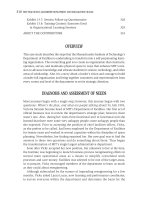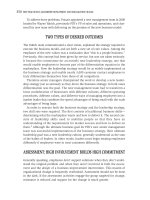Tài liệu Leadership & success In organizations, Culture & Ethics pptx
Bạn đang xem bản rút gọn của tài liệu. Xem và tải ngay bản đầy đủ của tài liệu tại đây (831.04 KB, 186 trang )
L
EADERSHIP &
S
UCCESS
In Organizations, Culture & Ethics
Group or horizontal interactions
Marcus O. Durham, PhD
Robert A. Durham, PhD
Rosemary Durham
Dream Point Publishers
Tulsa
2
Leadership & Success
In Organizations, Culture & Ethics
Group or horizontal interaction
Contact:
THEWAY Corp.
P.O. Box 33124
Tulsa, OK 74153
www.ThewayCorp.com
Cover Design: Rosemary & Marcus Durham
Cover photo: “Natural Organization”, Fossil Rim Wildlife Center near
Glen Rose, Texas, taken by Rosemary Durham
Printed in United States of America
First printing by Fidlar Doubleday, January 2005
Second printing by Fidlar Doubleday, January 2006
Library of Congress Control Number
ISBN: 978-0-9719324-5-X
Copyright © 2005-2006 by Marcus O. Durham
All rights reserved under International Copyright Law. Contents and/or
cover may not be reproduced in whole or in part in any form without the
express written consent of the Publisher.
3
4
5
TO
Pettie Beason Durham, my Mom, who taught me by getting things
done while others were thinking about it.
In Memoriam:
William O. Durham, D. Min., my Dad, who taught me about
leadership through example, before I knew its importance. During
his youth, because of the Great Depression, he only went through
the eighth grade. At age 79, he completed his Doctorate.
⇐
⇑ ⇒
6
TABLE OF CONTENTS
Title Page .......................................................................... 1
Leadership & success series.......................................... 12
Where we are going 11
1. Leadership and success..........................................................13
Leader or manager? 13
Tech 14
Success 16
DOS 16
Success machine model 17
Plan 19
Goal setting 20
Universal symbol 21
Relationships 23
Only 3 negatives 24
Time 25
Aphorisms 26
Make it happen 26
Review 28
2. Change: Paradigm shifts........................................................30
Abstract 30
Introduction 31
History 31
Life cycle 32
Extending the life cycle 33
Theory of technology 36
Theory of economics 37
Theory of information 40
Limits on technology 43
Shift of costs 44
People placement 46
Future for technologists 48
Future for education 49
Future of organizations 51
Table of Contents 7
Review 52
3. Nature of business...................................................................55
Background 55
The purpose of business 56
Players in a business 57
Companies get clients 59
The internet works as advertising 59
Business makes money 60
Structure of success 60
System of business 61
What is the relationship between businesses? 63
Good business 64
Success in producing income 65
Rules of the road 66
Review 66
4. Organizational structure........................................................68
Pyramid 68
Constraints 69
Authority 70
Relationship correlation 72
Organizational functions 72
Management functions 75
Risk management 76
Organizational structure 79
Review 81
5. Organizational resources .......................................................83
Carry over 83
Performers 83
Resources 87
Value trade-off 90
Vision timing 91
Tax Implications 94
Functions together 96
Review 97
6. Purpose, vision, plan...............................................................99
Purpose, vision, plan 99
Military discipline 101
Strategy, tactics, and technology 102
Strategic planning 104
Design 106
Start-up 108
8 Leadership & Success in Organization & Culture Durham
Contrast 108
Cost based 109
Reality check 110
Review 111
7. Negotiation ............................................................................113
Principles 113
Negotiating Game 114
Effective elements 116
Art of agreement 119
Review 122
8. Culture & leadership............................................................124
What is it 124
Cross-culture 124
Language 126
Cross-cultural confusion 126
Organizational culture 127
Implement organization culture 129
Remote management 130
Performance review 132
Review 134
9. Global leadership..................................................................136
Global perspective 136
Global power 137
Global protector 138
Pacific Rim 139
European Community 141
Education 142
Education reason 143
Culture 145
TV is not culture 146
Technology 149
Technology research 151
Review 152
10. Ethics and professionalism ..................................................154
Ethics 154
Ethics vs law 157
Perception 158
Who is on first 159
A smattering of ethical challenges 160
When in Rome 163
Review 165
Table of Contents 9
11. Benjamin Franklin Junto.....................................................168
Model 168
Goal 170
Questions 170
Assignment 172
Rules of Order 173
Schedule 173
Commentary 173
Application 174
12. Review via aphorisms...........................................................175
A pithy saying 175
Principles 178
End 179
13. About the authors.................................................................180
Personal - MOD 180
Marcus O. Durham 182
Robert A. Durham 183
Rosemary Durham 184
Cover 185
⇐
⇑ ⇒
10
PREFACE
Everything we know is developed from something we have read,
heard, or seen. Therefore, these other thoughts necessarily influence
what we write. To the best of our knowledge, we have given
specific credit where appropriate.
Rather than footnotes or references, we have listed the works that
have provided significant information in one way or another, since
this is often in concepts rather than quotes.
Statements that are attributed to us are things we have used
commonly and do not recall seeing from someone else. Others
obviously have similar thoughts. If we have made an oversight in
any credits, we apologize and we would appreciate your comments.
⇐
⇑ ⇒
11
LEADERSHIP & SUCCESS SERIES
Thought
People are where they are
because of the choices they make
MOD
Where we are going ______________
How vast is the topic of Leadership and Success? How can you
benefit from skills in leadership? Can there be success without
leadership in some area? Are the principles the same for an
individual, a group, or a society? Are the practices the same for an
individual, a group, or a society? Is this a topic that can be taught or
is it something that is innate? How do you define leadership? What
is success?
These are just some of the questions answered in the series on
Leadership and Success. The topic is too broad for a single book. A
series of three volumes provide the foundations for continued
personal development and growth.
Each book in the Leadership & Success series addresses a different
group of topics, each related to your success as a leader. The
structure of this series is based on the three areas of leadership
involvement: internal development, horizontal interactions, and
vertical relationships. The progression of the three books is arranged
in the order in which you, as a leader, can have the most impact:
people, organization, and society.
The first book, on relationships and communication, deals with
individual relationships and how others perceive you. These
chapters are primarily involved with areas that you can impact
12 Leadership & Success in Organization & Culture Durham
directly. Relationships and communication is most interesting and
intriguing. Think about it. Everything we do is defined by how we
interact with others, while the topic of communication includes
everything from individuals to presentations and visual cues.
The second book, on organizations, culture, and ethics, deals with
the makeup of a venture or association. These chapters are primarily
oriented toward optimizing the performance within a group that may
be global. Think about it. Our culture is defined by how we interact
with others, while the topic of organizations includes everything
from businesses to social groups and even families.
The final book, on economics, law, and technology, concentrates on
the influences of society and groups outside your sphere. Society
includes everything that is outside of an organization. Economics
impacts the amount of money in your bank account. This book has
practical, day-to-day keys that you can use to make your venture
successful.
How is the best way to use the series? Because each is a stand alone
work, they can be used individually or as a group. The method
depends on the forum and the needs.
The books are structured for seminars as well as personal study. The
chapters are configured for a one to one-and-a-half hour discussion.
By completing all the activities, most chapters can require three to
four hours. Although the combination of books makes an excellent
text for a technical and engineering management course or
executive development programs, they are beneficial to anyone
desiring to improve.
These topics will be approached from the context of communication
and relationships, and will follow closely the principles developed
in the first book in the series. The remainder of the books will
discuss components of leadership and management, and will include
people relationships, organizations, and the tools necessary for
success. The topics, then, will include both the application and
implementation elements of a successful leader or a manager.
⇐
⇑ ⇒
1
LEADERSHIP AND SUCCESS
Thought
Leadership is
an infectious passion,
a winning attitude,
and right action.
MOD
Leader or manager? ______________
What is leadership? What is the difference between leadership and
management? How does leadership relate to the individual?
Would you agree that leadership is often something that you
recognize in someone, but cannot quite describe?
Roget’s Interactive Thesaurus, First Edition provides the following
synonyms for leadership: authority, command, control, conveyance,
direction, directorship, domination, foresight, hegemony, influence,
initiative, pilotage, power, pre-eminence, primacy, skill, superiority,
and supremacy. [Roget]
The book on Relationships & Communications focused on
developing leadership styles. Now, let us relate that to organizations
by creating a working definition.
Leadership is an infectious passion, a winning attitude, and right
action.
14 Leadership & Success in Organization & Culture Durham
There is another definition of leadership that is more process
related.
Leadership is the process of influencing more than one person
toward a goal.
A manager implements the vision of the leader. A very pragmatic
definition of a manager is that he is a leader without the vision or
passion. That is not a derogatory comment. Managers are critical to
the success of every organization.
Our focus will remain on the overall picture of a leader. Since the
manager’s function is to execute the plan of the leader, then the
same principles apply to managers.
Influence, in itself, does not necessarily mean leadership. There are
many situations where influence may be exerted, but leadership may
be lacking. Influence may be applied by force of law, by force of
position (such as with a supervisor), by influence of a group (peer
pressure), or through fear of reprisals. A true leader exercises
influence, without the need for any external power or influence.
Tech ___________________________
Due to the rapidly changing nature of technology in today’s world,
one area that must be addressed is leadership involving people
active with technology. Despite the unique nature of technology
people, the basic skills remain the same as in any arena of
leadership. The major part of this treatise, then, is applicable to all
leaders. The principal differences of leaders in a world gone tech are
related to the type of people with which a leader will deal in the tech
world.
The people that make up a tech world include engineers, scientists,
and people that work with numbers. What is different about these
people? At their heart, all people are the same, and each is unique.
Chapter 1 Leadership & Success 15
However, there are some key characteristics that tend to appear
more frequently among this group of individuals.
• They have advanced education in sophisticated topics.
• They tend to be fast learners.
• They can absorb facts quickly, but may not readily grasp the
broader interactions.
• Often they have focused on technical interests to the exclusion
of developing relationship skills.
• They are more affluent that the average populace.
• Because they are creative, they tend to question tradition.
• Conversely, once they have made up their mind, they may be
rigid in their way of thinking because they have developed their
position with a certain logic.
Would that type of person intimidate you or your ability to lead? It
should not. Once they understand the process and what is required
of them, tech people tend to be very dedicated and loyal.
Now consider technical people as leaders. Bennett refers to a
Carnegie Foundation report using over 30 years of surveys. The
report showed that 60% of persons with an engineering degree
became managers or businessmen within 15 years. [Bennett].
Cleland and Kogaolu found that 40% of industrial executives and
34% of all top corporate managers in the US have an engineering
education. [Cleland]
It is clear that you will likely interact with a technical individual as
either a colleague or executive. Regardless of your particular
education or position, then, it is prudent to develop those
relationship skills that can relate to tech people, as well as to the
general populace.
One of the challenges for technical people is the rapid speed with
which they acquire information. When training technical people to
move into non-technical areas, such as people relationships and
management, they tend to grasp the facts very quickly. Therefore,
they can appear to know the material, even if they have only surface
16 Leadership & Success in Organization & Culture Durham
information. When teaching them it is important to develop ongoing
feedback in order to affirm the application of the information.
Success _________________________
Leadership is the process of developing and implementing ideas.
Each business owner has his own definition of success. Managers,
analysts, and non-owners have different perspectives. Therefore,
their description will often be dissimilar.
Success is simply meeting your goals or objectives in a particular
time frame.
From my position as owner and developer of several businesses, as
well as an educator, success is providing a useful service to clients
and making money for the owner.
As a scientist and researcher, I tend to look for patterns of cause and
effect to describe and define how things work. This process can also
apply to understanding personal relationships and business ventures.
A pattern that recurs in every physical system is the triad principle.
“Any item that can be uniquely identified can be further explained
by three components or members.”
- MOD
DOS ___________________________
Based on the definitions of leadership and success there must be a
dream, goal, or target. If there is no target, how can you know if you
have hit it? There is a familiar acronym left over from the early days
of personal computers, which can be applied to success. We will
define this acronym, DOS, to stand for Dream – Overcome –
Success.
Dream is a vision or passion. It is an objective or target that will
take time to achieve. An ancient proverb shows what happens
without this target.
Chapter 1 Leadership & Success 17
“…without a vision, the people perish.”
- Proverbs
Overcome is the physical process of getting past obstacles that will
come. Every venture, every task, every action has obstacles. The
secret to victory was declared by British Prime Minister Winston
Churchill during the difficult times of World War II. [Churchill]
“Never give in. Never give in. Never, never, never, never--in
nothing, great or small, large or petty--never give in, except to
convictions of honour and good sense. Never yield to force. Never
yield to the apparently overwhelming might of the enemy.”
- Winston Churchill
Success is an attitude. It is a continuing mental process and not an
end or destination. It is the continual journey of seeing, striving,
overcoming, achieving and seeing again. Success is achieving a
goal, and then resetting your vision on a new goal.
Success machine model ____________
A control system model, or diagram, can graphically illustrate the
interaction and responses to a certain situation. This response can be
referred to as your success machine. Proper tuning and fuel for your
machine breeds success, while negative reactions and a lack of
nourishment cause atrophy and demise. A simplified control system
model is shown below.
mental
physical
+/-
stimulus
emotional
An outside influence, or stimulus, stimulates an emotional reaction.
The emotional response promotes a physical reaction. The mental
18 Leadership & Success in Organization & Culture Durham
faculties analyze the result and cause a feedback, or modification of
the perception or emotional response.
The three responses, or elements of the control system, can be
referred to in a variety of ways..
Emotional Physical Mental
Dream Obstacles Success
Appetite Action Attitude
Passion Performance Prayer
Feelings Results Spirit
Heart Hands Head
The mental feedback is the way you choose to act. In any control
system, positive feedback causes an expansion that, unchecked,
ultimately approaches an explosion. Similarly, negative feedback
causes decline until a steady state of zero, or nothing, is reached.
The same is true of your choices. Positive feedback causes growth.
Negative feedback causes destruction.
People are where they are because of the choices they make.
- MOD
You must feed each of the areas of the control or response system.
Without nourishment, that area of your success machine will cease.
Some of the ways your can feed your machine are illustrated for
each of the control areas.
A dream is the process of feeding the emotions by look, touch, or
pictures of where you want to be. It is a reminder of why you are
doing what you are doing.
The physical part of the system is the technical aspect of your
business or venture. Overcome obstacles by physical action or work.
At least once a year, attend and participate in a technical conference
related to your field. This not only allows you an opportunity to
keep up on the state of the art, but also can provide valuable
interaction and networking opportunities.
Chapter 1 Leadership & Success 19
The mental portion of your success machine is driven by your
attitude. Attitude is developed by what you read, what you hear, and
with whom you associate. Attending a couple of motivational or
sales conferences a year enhances attitude, as does reading and
studying books and biographies written by proven leaders. The time
and effort will pay tremendous dividends.
Attitude is what keeps you going when the competition quits.
In all areas, it is imperative to have a mentor that can give you
insight into regions that you do not have experience, or in which
you need improvement. A personal mentor is fantastic. If that is not
available, you must create a surrogate.
Your mentor for each area need not be the same person. In the
technical areas of your business, this could be a more experienced,
highly skilled professional in the same field. This is often the easiest
person to find.
Your mentor for your emotional or mental areas should be similarly
skilled and experienced in those areas. Choose people that have
success that you can draw from. To learn about attitude, choose
someone that has a good attitude. To gain skills when dealing with
your emotions, find someone that believes in you and your success,
and can help you see where you are going.
Plan ____________________________
Your dream or vision does not change. It is your destination. It may
be refined as you gain experience, but the basic objective stays the
same.
The plan is the path that you take to get to your objection. It will
change. There is more than one way to accomplish any goal. The
plan is the process of going over, under, around, or through a
challenge.
20 Leadership & Success in Organization & Culture Durham
Consider an example. When I start to go to my ranch, that is my
vision. I can travel along many roads. Some are shorter, but have
more stops. Others are circuitous, but go around some of the
challenges. I do not care what plan or path I use. I simply want to
get there with the resources I have available.
The desired route may not be the fastest or the most efficient; it may
be the most scenic, the most relaxing, or a route that allows you to
accomplish other things along the way. Similarly, the desired path
to your goal may not be the one that is the most direct. Other factors
such as family, relationships, health, and other commitments must
influence the plan.
Technologists tend to choose the most logical, most efficient plan,
and stick doggedly to it regardless of changes, challenges, obstacles,
or other factors. The key is the ultimate vision. No route, or plan, is
sacred.
If one plan does not work, chuck it. Get another one. Just keep your
focus on where you want to go.
Goal setting _____________________
There is a long-established story about goal setting.
A Yale University study was conducted in 1953. Part of the research
asked about goals. Only 3% of the respondents had written,
definitive goals. The group was tracked 20 years later. The goal-
setting group had more net-worth than the other 97% combined.
Although the original report has not been identified, or documented,
the results of the study have been perpetuated in numerous forums,
and have reached the point of folklore. In our own surveys with
students, we have found similar results.
It is critical that you write down your goals and define a time that
you want them accomplished. Often goals are not written because
Chapter 1 Leadership & Success 21
people do not want to fail Some people consider it a failure if they
do not meet the goals in the time frame identified.
If you do not make a goal on time, it is not a failure. It is merely
another obstacle to overcome. Goals are a target or process, they are
not a destination.
If you do not make the date, you still have the goal. Simply refine
the plan and change the date. The goal, the dream, is still
unchanged.
A wag has said if you do not have a target you are sure to hit it.
- a wag
People do not often plan to fail; however, they often fail to plan.
- adage
Universal symbol _________________
What is the universal symbol of measurement? It is the dollar sign
($).
Money is the measurement of the success of a project, organization,
or business. If there is no money, then a business cannot complete
any of its plans. If your product, service, or ideas are not translated
to money, then they have no value in a commercial sense. As a
result you will receive no compensation for your effort.
Money is simply a means of keeping score. It is not the reason you
start a project. It is not the dream. The dream or vision is what you
can do with the money that you earn.
Each relationship is focused in one of three directions. These are
internal, horizontal, and vertical.
22 Leadership & Success in Organization & Culture Durham
Internal
Horizontal
Vertical
An alternative diagram conveys the same information.
Vertical
Internal
Horizontal
The respective business functions are technical, sales, and financial.
The internal aspect of a venture is related to the technical
characteristics
Businesses are customarily started by techno-leaders. The founder
thinks that they can do something better than others, and can be
successful doing it. The resulting enterprise is based primarily on
their skills. Initially, the technical area is the most crucial.
In order to grow an organization, it is obvious that other areas are
equally important. A business can buy technical people, but it
cannot buy a vision. That comes solely from the leader.
Sales are about horizontal relationships.
People do business with people they like and respect.
-MOD
A group can have the best technical solution and provide the most
value for its services. However, if no one knows about the company,
or buys the product, then both the client and the supplier lose.
Chapter 1 Leadership & Success 23
The financial and legal area is related to vertical relationships. It is
the process of extracting the most money from the enterprise. If
there is no money there is no business.
Even successful entertainers understand the importance of the
business aspects of their venture. The king of rock and roll, Elvis
Presley, had a lightning bolt with TCB painted on the tail of his
airplanes.
TCB – Taking Care of Business in everything we do.
-Elvis
It is important to point out one thing related to business. Contrary to
popular opinion, commerce is not about making a profit. The tax
laws discourage generation of profit. Trade is about creating cash
flow. The tax structure is established to encourage business to spend
money, thereby creating more money and jobs.
The difference in a wage income and income from a business is
illustrated by the ITS equation. I stands for income, T for taxes, and
S for spending. A wage earner has income. The first thing that is
taken from the check is taxes; he can then spend what is left. The
equation is I – T = S. A business has income. The company spends
whatever is necessary for the business. The business owner is the
sole arbiter of what is necessary to run his business. The business
then pays taxes on what is left. The equation is I – S = T.
With the same income, which option gives the owner more available
discretionary money?
Relationships ____________________
Perhaps the most difficult, but critical, area for success is
relationships. As observed earlier, without relationships, there is no
exchange, and there is no business.
24 Leadership & Success in Organization & Culture Durham
Techno-specialists tend to focus on their technical skills to the
detriment of relationships. In research for a paper on changing
paradigms, the authors found that a manager spends less that fifteen
percent of the time on technical issues. Eighty-five percent of a
manager’s time is devoted to dealing with people and money issues.
Interestingly, relationships and finance (horizontal and vertical) are
the areas that demand more focus and effort, but for which the
leader or entrepreneur is often most poorly equipped.
Dale Carnegie wrote perhaps the most popular book ever written on
the topic of relationships in 1939. In How to Win Friends and
Influence People Carnegie gave three basic criteria. [Carnegie]
1. Never criticize, ever.
2. Give positive affirmation.
3. Find what people want and help them get it. In the process you
will achieve what you want.
Only 3 negatives _________________
As illustrated earlier, positive feedback is critical to success. The
majority of this discourse will focus on what is positive, and what
you can do to achieve success. Unfortunately, there are three
negatives that are imperative for developing a successful venture.
Do not count on one source of income. Have multiple income
streams. One may be down while the others are up. Things do
change. What goes up will come down.
Do not have partners. Joint ventures or alliances are easier to make
and terminate. Everyone has a different dream. Things do change.
Others may want to go a different direction after the initial
excitement and euphoria of starting a new venture.
Starting is easy. Persistence is what makes winners.
Do not listen to “you cannot do that.” It is your dream. It is your
passion. Others cannot see it. Dream stealers say get real, quit
Chapter 1 Leadership & Success 25
dreaming. They have their own passions and do not have the interest
or motivation that drives you. You can do it.
Time ___________________________
A very common complaint in any situation is “I do not have enough
time.” Everyone is given the same 24 hours in the day. It is what
you do with those 24 hours that makes the difference.
On one extreme is the procrastinator. He postpones tasks until the
last minute. As a result, he and everyone around him is stressed, the
results are less than desirable, and the project will likely not be
finished on time or with the quality necessary. Frustration and
negative feedback often results.
On the opposite extreme is the task-oriented individual who thinks
she can do it and crams one more chore into an already busy
schedule. An early boss, Col. T. C. Rodebaugh, frequently
pontificated, “If you want something done, find the busiest person,
and give it to him.” This person also experiences stress, but has
learned to redirect it. The task will be done. The colonel’s
comments aggravated me at the time, because I often was
“awarded” the task. However, over time, the colonel’s position has
proven to be correct.
Many leaders fit in the task-oriented style, since they think they can
do something better than others. What suffers from this attitude?
Relationships are the first thing to go. As a result, the venture
ultimately suffers. In addition, the dream that was the leader’s drive
may be lost in the process.
Very few people fall into the balanced area of effective time
managers. These people are the successful individuals who have
learned to both balance work and smelling the roses. Guard your
time.
Time is the asset that can neither be increased nor recovered.









